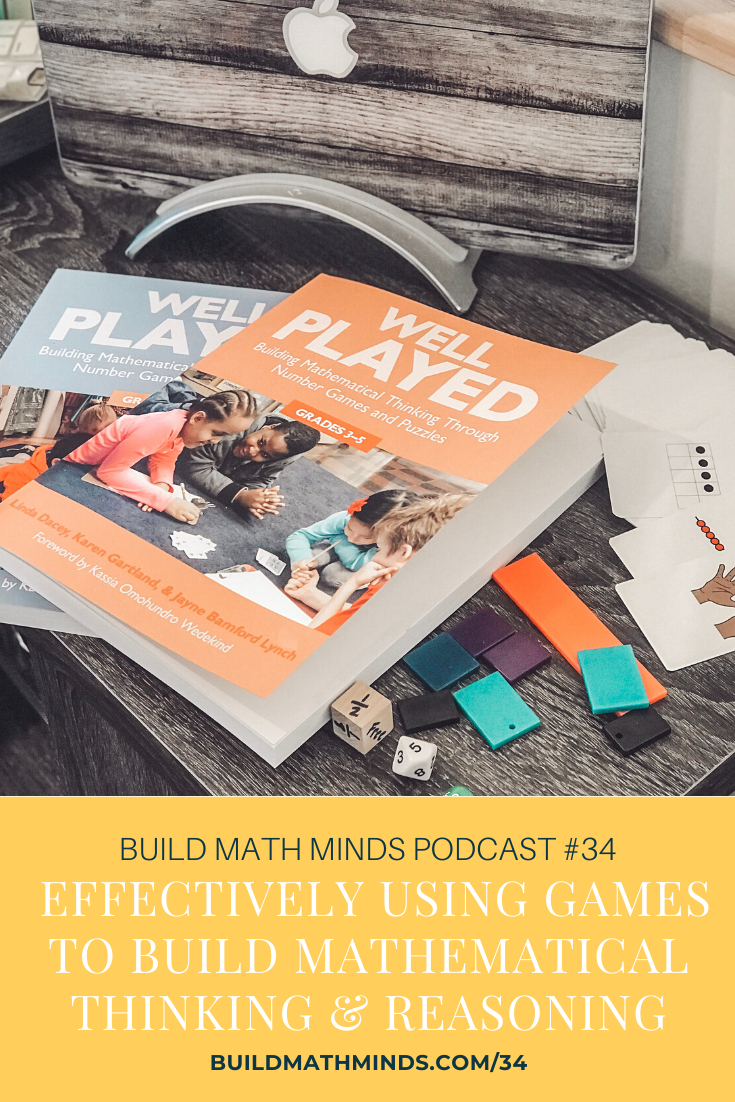Resources mentioned in this episode:
Well Played K-2 book
Well Played 3-5 book
Well Played 6-8 book (there is a 3rd one!)
**Use the code 19STEN10 to receive 10% off your order.
Member login for Build Math Minds PD site (I misspoke in the episode, Linda’s VMS session was in 2017, not the 2018 summit)
Join the waitlist for the Build Math Minds PD site
Welcome fellow Recovering Traditionalists to Episode 34. Today we are looking at Effectively Using Games to Build Mathematical Thinking & Reasoning.
Today’s insight comes from Well Played: Building Mathematical Thinking Through Number Games & Puzzles by Linda Dacey, Karen Gartland, and Jayne Bamford Lynch. As you hopefully know, I love Games. I grew up in a game playing family and still love playing games with my own children. So as I was preparing for a video I did recently over on my Vlog, The Recovering Traditionalist, I was reading back through the Well Played books. There is a book for K-2 and one for 3-5.
This paragraph from page 6 really made me stop and think about how we use games in the classroom:
“We believe that the instructional potential of games and puzzles could be further realized in most classrooms. Often we’ve seen them provided as activities with little follow-up or offered to students as choices after they have mastered the related mathematical content. We’ve seen that teachers who implement good teaching practices, such as asking significant debriefing questions after a problem-solving experience, often fall short of utilizing such practices with games and puzzles. Further, the games and puzzles used most frequently in classrooms tend to only develop procedural expertise, without attending to conceptual understanding. As a result, many students experience games or puzzles as fun activities or time fillers, but do not consider them as essential to their learning or as an important part of a lesson for which they are accountable.”
They go on in the book to discuss about different stages of opportunities to play games or solve puzzles that describe different ways we can use games in our classroom and how to support the different types of learning you want to happen when kids are playing games. Along with a lot of ideas for games you can play in your classroom. Now, as always with these podcasts, I don’t go into detail because if you are interested in these ideas, I think it’s important to go learn from the original source.
If you want to dig a bit deeper into how to effectively use games to build your students’ mathematical thinking, then I highly encourage you to read the Well Played book for your grade level. Also on the show notes page you will find a discount code that Stenhouse has given me to pass along to you so that you can get 10% off the book.
For those of you who are members of the Build Math Minds PD site, log into the site and click on the link for the Virtual Math Summit. During the 2017 Virtual Math Summit, Linda Dacey did a session about UnLeashing the Power of Games & Puzzles in K-5. Very cool session that you have access to inside the BMM PD site.
If you aren’t a member, then I’d encourage you to get on the waitlist. Registration for the site only opens once a year. So get your name on the list and I’ll notify you when it’s about to open. Just go to BuildMathMinds.com/bmm
Subscribe and Review in iTunes
Hey, are you subscribed to the Build Math Minds Podcast, yet? If you’re not, make sure to do that today because I don’t want you to miss any episodes! Click here to subscribe to the podcast in iTunes.
While you’re there, don’t forget to leave a review on iTunes too. I would love to know your thoughts and how we can make sure that we give you content that you will really enjoy.
To leave a review, head over to iTunes and click on “Ratings and Reviews” and “Write a Review.” I can’t wait to hear your thoughts about the podcast.





Trackbacks/Pingbacks